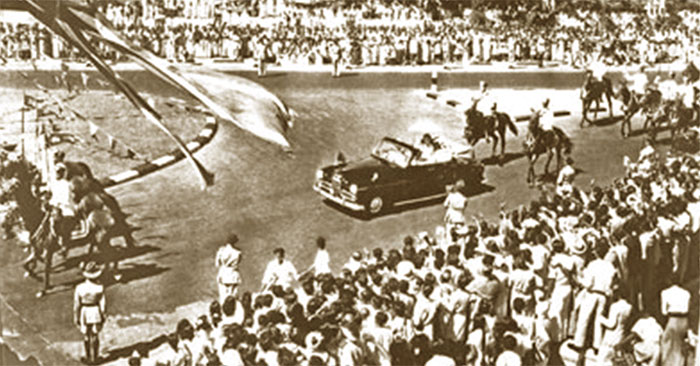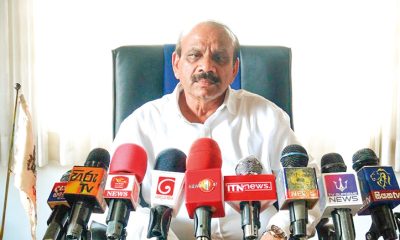Opinion
Celebrating 75th Anniversary of Independence

Ceylon, the resplendent luscious tropical island on the Indian Ocean, like a brilliant emerald on the beautiful pendant of Mother India, was an attraction from ancient times, to many great powers to acquire as a valuable possession. Unfortunately, From the 15th Century to the middle of the 20th Century, a period of almost 500 years the island was colonised by Portuguese, Dutch and British, finally managed to get its Independence from Britain in 1947.
Ancient historians wrote the chronical Mahavamsa relating the arrival of Prince Vijaya with his 700 followers from Sinhapura in North India and landed in this beautiful tropical island called Thambpani, married its Queen Kuveni, and became King and raised the first original Aryan Sinhala Race. It is rather an epic similar to Greek mythology, where a Greek warrior Odysseus landing in Crete with his 700 crew. Thambapani was then inhabited by tribes known as Yakkas and Nagas, probably Hindus from South India. They must have been highly intelligent as they accepted Buddhism when Emperor Asoka of North India sent, to his friend King Devanmpiyatissa, his son Mahinda Thera and a retinue of Buddhist monks to propagate Buddhism. That event was followed by the Emperor sending his daughter Sanghamitta with a sacred Bo-sapling to be planted in Anuradhapura in 250BC which is still alive.
The island flourished. King Dutugemunu built in the City of Anuradhapura in the North Central province, a huge Chaitya known as Ruwanweli Maha Seya, entombing relics of The Buddha and practiced Buddhism in its purest form. Later, King Prakarmabahu during his reign converted several lakes in Polonnaruwa to enormous tanks to preserve rain water from flowing to the sea and use it for cultivation of rice and other grains. The inhabitants were mostly farmers, who cultivated rice on a grand scale for export to the neighboring countries. Even when Britain colonised the island in about 1800, praised the country as ‘The Granary of the East.’
From ancient times the Northern region in the island was a kingdom occupied by Tamils due to its closeness to South India. It happened during the reign of King Elara, a Tamil, there was a war between the Sinhalese and Tamil kingdoms. and King Elara was killed by King Dutugemunu. Feeling sad and to show respect for Elara, he built a monument ordering all who pass it to bow their head in abeyance.
Although there were invasions from South India, some Sinhala kings married South Indian princesses and built for their worship Hindu Kovils in temple premises. Even now, Buddhist worshippers would pay small bribes panduru to seek favours from the Hindu gods. Thus, the Sinhalese acquired a great deal of Indian culture in addition to Buddhism due its closeness to India. Muslim Arabs from the Middle East traded in the coastal regions of the island, for spices precious stones and pearls on their way to the East, settled down in the island and named it Serendib and became inhabitants as Muslims, building Mosques for worship.
The Portuguese arrived in the island for trade in in the 15th Century. They colonised and built churches and introduced Christianity to the coastal fishing folks, and baptised them with Christian names prefixed with the Portuguese title Don. Even the last king of Kotte was baptized and given the name Don Juan Dharmapala. Many Sinhalese in towns and cities for favor changed their religion and acquired Portuguese names. After about 280 years of occupation the Dutch took over from the Portuguese, and colonised for another 250 years or so, and propagated Christianity further, and building more churches, networks of canals for transport produce and Introduced Roman Dutch Laws for governing.
In the 1800 or so, the country was taken over by the British and became a British Colony. The country gained from introduction English education in schools and colleges and the first University in Kandy. Modern roads, railways, bridges, harbours were built and governed by highly efficient educated Civil Servants in charge of the nine Provinces. The British at first introduced coffee plantations, but was destroyed by blight, and Tea was introduced covering thousands and thousands of acres in the hill country and exported to countries all over the world. Ceylon Tea became known worldwide for its pleasant aroma and became the islands main product in addition to Rubber.
Colombo became the commercial capital of South East Asia and its harbour was named by Britain as ‘The Clapham Junction of Eastern Shipping,’ Its popularity spread for ships from Europe to the Far East to bunker fuel, water and victualling. Ceylon was considered the brightest gem on the British Crown as there was peace and prosperity and goodwill among the people.
Unfortunately, WWII broke out in 1939 by Germany and Japan attacking neighbouring countries and the whole world was involved. Ceylon contributed Tea and Rubber and its produce to Britain, Ceylonese fighter pilots, air mechanics, naval ratings and soldiers. The war ended in 1944 when American bombed Hiroshima and Nagasaki with atom bombs destroying them in a few seconds. Peace prevailed all over the globe. Colonial ruled countries clamoured for freedom and India received Independence from Britain on 15th August 1947 and Ceylon was granted Independence the following year on February 1948.
It was a happy and momentous event for Ceylon to be given Independence in 1948 without spilling a single drop of blood. The Union Jack was lowered; Ceylon’s national flag was hoisted. The national anthem was sung, a 21-gun salute was fired, and Britain’s Governor General proclaimed Ceylon an Independent country in the British Commonwealth. In 1972 Ceylon became a Republic within the Commonwealth and changed its name to SRI LANKA.
It is almost 75 years since Sri Lanka obtained Independence from Britain and unfortunately the country was misruled and ruined by ignorant avaricious unpatriotic Sinhalese leaders fighting for power. It is now a bankrupt nation and 80% of the population is starving without food, fuel and medicine. It a disgrace to plan celebrating 75 years of ‘misrule’ as ‘75 years of Independence.’ The 4th February 2023 should be a day of repentance and religious prayers to God, Allah and all the Devas to make Sri Lanka a prosperous and happy nation, with freedom and equality to all its multinational and multireligious citizens in the very near future.
The writer, D. L. Sirimanne from Kohuwala is 103 years old
Opinion
Lakshman Balasuriya – Not just my boss but a father and a brother

It is with profound sadness that we received the shocking news of untimely passing of our dear leader Lakshman Balasuriya.
I first met Lakshman Balasuriya in 1988 while working at John Keells, which had been awarded an IT contract to computerise Senkadagala Finance. Thereafter, in 1992, I joined the E. W. Balasuriya Group of Companies and Senkadagala Finance when the organisation decided to bring its computerisation in-house.
Lakshman Balasuriya obtained his BSc from the University of London and his MSc from the University of Lancaster. He was not only intellectually brilliant, but also a highly practical and pragmatic individual, often sitting beside me to share instructions and ideas, which I would then translate directly into the software through code.
My first major assignment was to computerise the printing press. At the time, the systems in place were outdated, and modernisation was a challenging task. However, with the guidance, strong support, and decisive leadership of our boss, we were able to successfully transform the printing press into a modern, state-of-the-art operation.
He was a farsighted visionary who understood the value and impact of information technology well ahead of his time. He possessed a deep knowledge of the subject, which was rare during those early years. For instance, in the 1990s, Balasuriya engaged a Canadian consultant to conduct a cybersecurity audit—an extraordinary initiative at a time when cybersecurity was scarcely spoken of and far from mainstream.
During that period, Senkadagala Finance’s head office was based in Kandy, with no branch network. When the decision was made to open the first branch in Colombo, our IT team faced the challenge of adapting the software to support branch operations. It was him who proposed the innovative idea of creating logical branches—a concept well ahead of its time in IT thinking. This simple yet powerful idea enabled the company to expand rapidly, allowing branches to be added seamlessly to the system. Today, after many upgrades and continuous modernisation, Senkadagala Finance operates over 400 locations across the country with real-time online connectivity—a testament to his original vision.
In September 2013, we faced a critical challenge with a key system that required the development of an entirely new solution. A proof of concept was prepared and reviewed by Lakshman Balasuriya, who gave the green light to proceed. During the development phase, he remained deeply involved, offering ideas, insights, and constructive feedback. Within just four months, the system was successfully developed and went live—another example of his hands-on leadership and unwavering support for innovation.
These are only a few examples among many of the IT initiatives that were encouraged, supported, and championed by him. Information technology has played a pivotal role in the growth and success of the E. W. Balasuriya Group of Companies, including Senkadagala Finance PLC, and much of that credit goes to his foresight, trust, and leadership.
On a deeply personal note, I was not only a witness to, but also a recipient of, the kindness, humility, and humanity of Lakshman Balasuriya. There were occasions when I lost my temper and made unreasonable demands, yet he always responded with firmness tempered by gentleness. He never lost his own composure, nor did he ever harbour grudges. He had the rare ability to recognise people’s shortcomings and genuinely tried to guide them toward self-improvement.
He was not merely our boss. To many of us, he was like a father and a brother.
I will miss him immensely. His passing has left a void that can never be filled. Of all the people I have known in my life, Mr. Lakshman Balasuriya stands apart as one of the finest human beings.
He leaves behind his beloved wife, Janine, his children Amanthi and Keshav, and the four grandchildren.
May he rest in eternal peace!
Timothy De Silva
(Information Systems Officer at Senkadagala Finance.)
Opinion
The science of love

A remarkable increase in marriage proposals in newspapers and the thriving matchmaking outfits in major cities indicate the difficulty in finding the perfect partners. Academics have done much research in interpersonal attraction or love. There was an era when young people were heavily influenced by romantic fiction. They learned how opposites attract and absence makes the heart grow fonder. There was, of course, an old adage: Out of sight out of mind.
Some people find it difficult to fall in love or they simply do not believe in love. They usually go for arranged marriages. Some of them think that love begins after marriage. There is an on-going debate whether love marriages are better than arranged marriages or vice versa. However, modern psychologists have shed some light on the science of love. By understanding it you might be able to find the ideal life partner.
To start with, do not believe that opposites attract. It is purely a myth. If you wish to fall in love, look for someone like you. You may not find them 100 per cent similar to you, but chances are that you will meet someone who is somewhat similar to you. We usually prefer partners who have similar backgrounds, interests, values and beliefs because they validate our own.
Common trait
It is a common trait that we gravitate towards those who are like us physically. The resemblance of spouses has been studied by scientists more than 100 years ago. According to them, physical resemblance is a key factor in falling in love. For instance, if you are a tall person, you are unlikely to fall in love with a short person. Similarly, overweight young people are attracted to similar types. As in everything in life, there may be exceptions. You may have seen some tall men in love with short women.
If you are interested in someone, declare your love in words or gestures. Some people have strong feelings about others but they never make them known. If you fancy someone, make it known. If you remain silent you will miss a great opportunity forever. In fact if someone loves you, you will feel good about yourself. Such feelings will strengthen love. If someone flatters you, be nice to them. It may be the beginning of a great love affair.
Some people like Romeo and Juliet fall in love at first sight. It has been scientifically confirmed that the longer a pair of prospective partners lock eyes upon their first meeting they are very likely to remain lovers. They say eyes have it. If you cannot stay without seeing your partner, you are in love! Whenever you meet your lover, look at their eyes with dilated pupils. Enlarged pupils signal intense arousal.
Body language
If you wish to fall in love, learn something about body language. There are many books written on the subject. The knowledge of body language will help you to understand non-verbal communication easily. It is quite obvious that lovers do not express their love in so many words. Women usually will not say ‘I love you’ except in films. They express their love tacitly with a shy smile or preening their hair in the presence of their lovers.
Allan Pease, author of The Definitive Guide to Body Language says, “What really turn men on are female submission gestures which include exposing vulnerable areas such as the wrists or neck.” Leg twine was something Princess Diana was good at. It involves crossing the legs hooking the upper leg’s foot behind the lower leg’s ankle. She was an expert in the art of love. Men have their own ways. In order to look more dominant than their partners they engage in crotch display with their thumbs hooked in pockets. Michael Jackson always did it.
If you are looking for a partner, be a good-looking guy. Dress well and behave sensibly. If your dress is unclean or crumpled, nobody will take any notice of you. According to sociologists, men usually prefer women with long hair and proper hip measurements. Similarly, women prefer taller and older men because they look nice and can be trusted to raise a family.
Proximity rule
You do not have to travel long distances to find your ideal partner. He or she may be living in your neighbourhood or working at the same office. The proximity rule ensures repeated exposure. Lovers should meet regularly in order to enrich their love. On most occasions we marry a girl or boy living next door. Never compare your partner with your favourite film star. Beauty lies in the eyes of the beholder. Therefore be content with your partner’s physical appearance. Each individual is unique. Never look for another Cleopatra or Romeo. Sometimes you may find that your neighbour’s wife is more beautiful than yours. On such occasions turn to the Bible which says, “Thou shalt not covet thy neighbour’s wife.”
There are many plain Janes and penniless men in society. How are they going to find their partners? If they are warm people, sociable, wise and popular, they too can find partners easily. Partners in a marriage need not be highly educated, but they must be intelligent enough to face life’s problems. Osho compared love to a river always flowing. The very movement is the life of the river. Once it stops it becomes stagnant. Then it is no longer a river. The very word river shows a process, the very sound of it gives you the feeling of movement.
Although we view love as a science today, it has been treated as an art in the past. In fact Erich Fromm wrote The Art of Loving. Science or art, love is a terrific feeling.
karunaratners@gmail.com
By R.S. Karunaratne
Opinion
Are we reading the sky wrong?

Rethinking climate prediction, disasters, and plantation economics in Sri Lanka
For decades, Sri Lanka has interpreted climate through a narrow lens. Rainfall totals, sunshine hours, and surface temperatures dominate forecasts, policy briefings, and disaster warnings. These indicators once served an agrarian island reasonably well. But in an era of intensifying extremes—flash floods, sudden landslides, prolonged dry spells within “normal” monsoons—the question can no longer be avoided: are we measuring the climate correctly, or merely measuring what is easiest to observe?
Across the world, climate science has quietly moved beyond a purely local view of weather. Researchers increasingly recognise that Earth’s climate system is not sealed off from the rest of the universe. Solar activity, upper-atmospheric dynamics, ocean–atmosphere coupling, and geomagnetic disturbances all influence how energy moves through the climate system. These forces do not create rain or drought by themselves, but they shape how weather behaves—its timing, intensity, and spatial concentration.
Sri Lanka’s forecasting framework, however, remains largely grounded in twentieth-century assumptions. It asks how much rain will fall, where it will fall, and over how many days. What it rarely asks is whether the rainfall will arrive as steady saturation or violent cloudbursts; whether soils are already at failure thresholds; or whether larger atmospheric energy patterns are priming the region for extremes. As a result, disasters are repeatedly described as “unexpected,” even when the conditions that produced them were slowly assembling.
This blind spot matters because Sri Lanka is unusually sensitive to climate volatility. The island sits at a crossroads of monsoon systems, bordered by the Indian Ocean and shaped by steep central highlands resting on deeply weathered soils. Its landscapes—especially in plantation regions—have been altered over centuries, reducing natural buffers against hydrological shock. In such a setting, small shifts in atmospheric behaviour can trigger outsized consequences. A few hours of intense rain can undo what months of average rainfall statistics suggest is “normal.”
Nowhere are these consequences more visible than in commercial perennial plantation agriculture. Tea, rubber, coconut, and spice crops are not annual ventures; they are long-term biological investments. A tea bush destroyed by a landslide cannot be replaced in a season. A rubber stand weakened by prolonged waterlogging or drought stress may take years to recover, if it recovers at all. Climate shocks therefore ripple through plantation economics long after floodwaters recede or drought declarations end.
From an investment perspective, this volatility directly undermines key financial metrics. Return on Investment (ROI) becomes unstable as yields fluctuate and recovery costs rise. Benefit–Cost Ratios (BCR) deteriorate when expenditures on drainage, replanting, disease control, and labour increase faster than output. Most critically, Internal Rates of Return (IRR) decline as cash flows become irregular and back-loaded, discouraging long-term capital and raising the cost of financing. Plantation agriculture begins to look less like a stable productive sector and more like a high-risk gamble.
The economic consequences do not stop at balance sheets. Plantation systems are labour-intensive by nature, and when financial margins tighten, wage pressure is the first stress point. Living wage commitments become framed as “unaffordable,” workdays are lost during climate disruptions, and productivity-linked wage models collapse under erratic output. In effect, climate misprediction translates into wage instability, quietly eroding livelihoods without ever appearing in meteorological reports.
This is not an argument for abandoning traditional climate indicators. Rainfall and sunshine still matter. But they are no longer sufficient on their own. Climate today is a system, not a statistic. It is shaped by interactions between the Sun, the atmosphere, the oceans, the land, and the ways humans have modified all three. Ignoring these interactions does not make them disappear; it simply shifts their costs onto farmers, workers, investors, and the public purse.
Sri Lanka’s repeated cycle of surprise disasters, post-event compensation, and stalled reform suggests a deeper problem than bad luck. It points to an outdated model of climate intelligence. Until forecasting frameworks expand beyond local rainfall totals to incorporate broader atmospheric and oceanic drivers—and until those insights are translated into agricultural and economic planning—plantation regions will remain exposed, and wage debates will remain disconnected from their true root causes.
The future of Sri Lanka’s plantations, and the dignity of the workforce that sustains them, depends on a simple shift in perspective: from measuring weather, to understanding systems. Climate is no longer just what falls from the sky. It is what moves through the universe, settles into soils, shapes returns on investment, and ultimately determines whether growth is shared or fragile.
The Way Forward
Sustaining plantation agriculture under today’s climate volatility demands an urgent policy reset. The government must mandate real-world investment appraisals—NPV, IRR, and BCR—through crop research institutes, replacing outdated historical assumptions with current climate, cost, and risk realities. Satellite-based, farm-specific real-time weather stations should be rapidly deployed across plantation regions and integrated with a central server at the Department of Meteorology, enabling precision forecasting, early warnings, and estate-level decision support. Globally proven-to-fail monocropping systems must be phased out through a time-bound transition, replacing them with diversified, mixed-root systems that combine deep-rooted and shallow-rooted species, improving soil structure, water buffering, slope stability, and resilience against prolonged droughts and extreme rainfall.
In parallel, a national plantation insurance framework, linked to green and climate-finance institutions and regulated by the Insurance Regulatory Commission, is essential to protect small and medium perennial growers from systemic climate risk. A Virtual Plantation Bank must be operationalized without delay to finance climate-resilient plantation designs, agroforestry transitions, and productivity gains aligned with national yield targets. The state should set minimum yield and profit benchmarks per hectare, formally recognize 10–50 acre growers as Proprietary Planters, and enable scale through long-term (up to 99-year) leases where state lands are sub-leased to proven operators. Finally, achieving a 4% GDP contribution from plantations requires making modern HRM practices mandatory across the sector, replacing outdated labour systems with people-centric, productivity-linked models that attract, retain, and fairly reward a skilled workforce—because sustainable competitive advantage begins with the right people.
by Dammike Kobbekaduwe
(www.vivonta.lk & www.planters.lk ✍️
-

 News6 days ago
News6 days agoBritish MP calls on Foreign Secretary to expand sanction package against ‘Sri Lankan war criminals’
-

 News5 days ago
News5 days agoStreet vendors banned from Kandy City
-

 Sports6 days ago
Sports6 days agoChief selector’s remarks disappointing says Mickey Arthur
-

 Opinion6 days ago
Opinion6 days agoDisasters do not destroy nations; the refusal to change does
-

 News5 days ago
News5 days agoLankan aircrew fly daring UN Medevac in hostile conditions in Africa
-

 Sports2 days ago
Sports2 days agoGurusinha’s Boxing Day hundred celebrated in Melbourne
-

 Sports3 days ago
Sports3 days agoTime to close the Dickwella chapter
-

 Sports6 days ago
Sports6 days agoRoyal record crushing innings win against Nalanda













